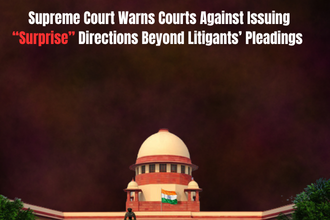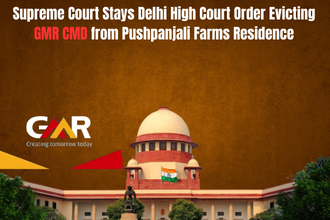In a significant reaffirmation of judicial restraint and procedural fairness, the Supreme Court of India has cautioned all courts against issuing “surprise directions” or adverse orders that go beyond the reliefs sought or issues raised by litigants in their pleadings. The Court warned that such judicial overreach could have a “chilling effect” on access to justice, discouraging citizens from approaching courts out of fear that they may end up worse off than before.
The judgment came in P. Radhakrishnan & Anr. v. Cochin Devaswom Board & Ors, delivered by a Bench comprising Justice Dipankar Datta and Justice K.V. Viswanathan.
Supreme Court’s Observation: Judicial Restraint Is Essential to Access to Justice
The apex court emphasized that courts exist to vindicate rights, not to penalize those who seek justice. The Bench observed that litigants approach courts expecting redress for perceived violations, but judicial unpredictability—where courts travel beyond the scope of pleadings—can severely undermine confidence in the legal process.
“Litigants go to court for vindicating their rights when they perceive that there is an infringement. The court may, after hearing both parties, grant or deny them relief. But if, without putting parties on notice, the court travels beyond the scope of the petition, takes parties by surprise and makes any strong observations or directions, it will create a chilling effect on other prospective litigants,” the Bench observed.
The Court warned that if citizens fear being rendered worse off by seeking redress, it would “seriously impact access to justice and consequently the very rule of law.” Hence, courts must exercise great caution and circumspection while adjudicating matters.
Case Background: Dispute Over Land and Licence Fee
The case originated from a dispute involving the Cochin Devaswom Board and representatives of the Chinmaya Mission Educational and Cultural Trust in Thrissur, Kerala.
The Trust had been allotted 13.5 cents of land by the Board in 1974 for the construction of a hall meant for religious, cultural, and marriage functions. The original conditions required that the hall be made available free of cost for Devaswom programs and pilgrims.
The annual licence fee was initially fixed at ₹101 and later revised to ₹227.25 in 1977. However, the fee remained unchanged for several decades thereafter.
In 2014, the Devaswom Board unilaterally raised the annual licence fee to ₹1.5 lakh and demanded arrears exceeding ₹20 lakh. The Trust challenged this sudden enhancement before the Kerala High Court, arguing that the fee hike was arbitrary and disproportionate.
Kerala High Court’s Decision and “Surprise” Directions
The Kerala High Court upheld the enhancement of the licence fee, finding no illegality in the Board’s decision. However, while disposing of the case, the High Court also issued two additional directions that had not been sought by either party:
- The Board was directed to refix the licence fee afresh.
- A vigilance inquiry was ordered into the original allotment of land to the Trust.
These directions went well beyond the issues raised in the Trust’s writ petition. The petitioner contended that it had approached the Court to challenge the steep increase in licence fee, not to invite a vigilance investigation into its land allotment — an order that effectively left it worse off for having sought judicial relief.
Appeal Before the Supreme Court
Aggrieved by these unexpected directions, the Trust approached the Supreme Court of India, arguing that the High Court’s actions violated the principles of natural justice. The appellants asserted that they were never put on notice about the possibility of such orders and were taken by complete surprise.
Senior Advocate Gaurav Agrawal appeared for the appellants, assisted by Advocates N.K. Unnikrishnan, Anu K Joy, Alim Anvar, Santhosh K, Devika A.I., and Smita Amratlal Vora.
Senior Advocate P.V. Dinesh appeared for the respondents, along with Advocates P.S. Sudheer, Anna Oommen, Rishi Maheshwari, Anne Mathew, Bharat Sood, Jai Govind M.J., Jashan Vir Singh, Harshad V. Hameed, Dileep Poolakkot, Ashly Harshad, Mahabir Singh, and Anshul Saharan.
Supreme Court’s Verdict: Directions Beyond Pleadings Are Impermissible
The Supreme Court agreed with the appellants and set aside the impugned directions of the Kerala High Court. It held that while the High Court was justified in upholding the enhancement of the licence fee, it had exceeded its jurisdiction by ordering a refixation of fees and a vigilance inquiry — neither of which formed part of the issues under consideration.
“We are of the opinion that the High Court was not justified in passing the directions. The directions were far beyond the scope of the writ petition. The appellants could not have been rendered worse off in their own writ petition. What is more, the directions have been made without putting the appellants on notice,” the Supreme Court held.
Accordingly, the Court expunged the paragraphs of the High Court’s order that directed the refixation of licence fee and initiation of a vigilance probe.
However, the Bench clarified that if the Cochin Devaswom Board has legitimate rights under law to enhance the licence fee, it may do so independently and in accordance with due process.
Principle of Natural Justice Reinforced
The judgment reiterates a core tenet of natural justice — that no person should be condemned unheard. The Supreme Court underscored that before passing any direction adverse to a party, courts must afford that party an opportunity to explain or defend itself.
It further observed that judicial activism must never cross into the realm of judicial overreach, especially in civil or writ proceedings where litigants approach the court for limited reliefs. Courts must remain within the confines of pleadings and prayers, and any extraordinary directions must be issued only after giving notice and hearing all affected parties.
The Bench also cited earlier precedents such as V.K. Majotra v. Union of India and Mohammad Naim v. State of Uttar Pradesh, which cautioned against courts venturing beyond the issues raised before them.
Broader Implications of the Ruling
The Supreme Court’s warning has wide-ranging implications for judicial discipline and procedural fairness across all levels of the judiciary.
- Preserving Access to Justice:
By acknowledging that “surprise” directions can deter people from approaching courts, the judgment directly links procedural fairness to the right to access justice, which is intrinsic to the rule of law. - Limiting Judicial Overreach:
The decision sends a clear message to lower courts that they must exercise restraint and avoid turning judicial proceedings into investigations or policy exercises not contemplated by the pleadings. - Ensuring Predictability and Trust:
Litigants must feel confident that courts will adjudicate only what is pleaded — no more, no less. Judicial predictability strengthens trust in the legal system and reinforces faith in constitutional governance. - Protecting Litigants from Adverse Consequences:
The Court’s insistence that no litigant should be left “worse off” for seeking redress ensures that judicial remedies remain protective, not punitive.
Conclusion
The Supreme Court’s judgment in P. Radhakrishnan & Anr. v. Cochin Devaswom Board & Ors is a vital reaffirmation of judicial restraint, procedural fairness, and the rule of law. By cautioning courts against passing “surprise” directions beyond the pleadings, the apex court has drawn a clear boundary between legitimate adjudication and judicial excess.
The ruling serves as a reminder that the judiciary’s greatest strength lies in balance — ensuring justice without overstepping the limits of jurisdiction. As the Court observed, when courts act unpredictably or beyond the scope of petitions, it undermines not just individual litigants but also public confidence in justice itself.
By restoring that balance, the Supreme Court has once again underscored its role as the guardian of fairness, natural justice, and access to justice for every citizen.
Also Read
When Decorum Breaks: The CJI BR Gavai Courtroom Incident and What It Means for India’s Judiciary



